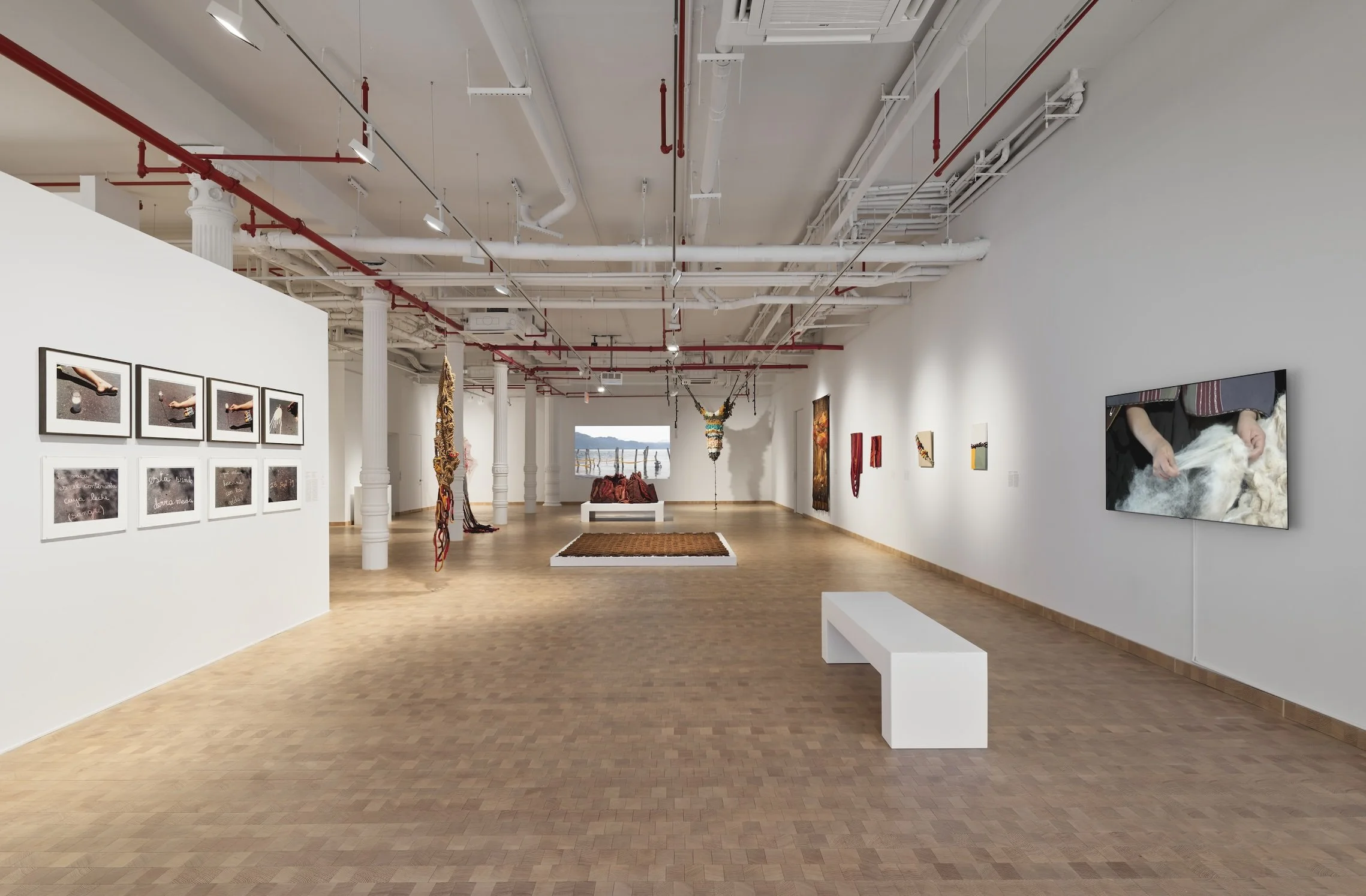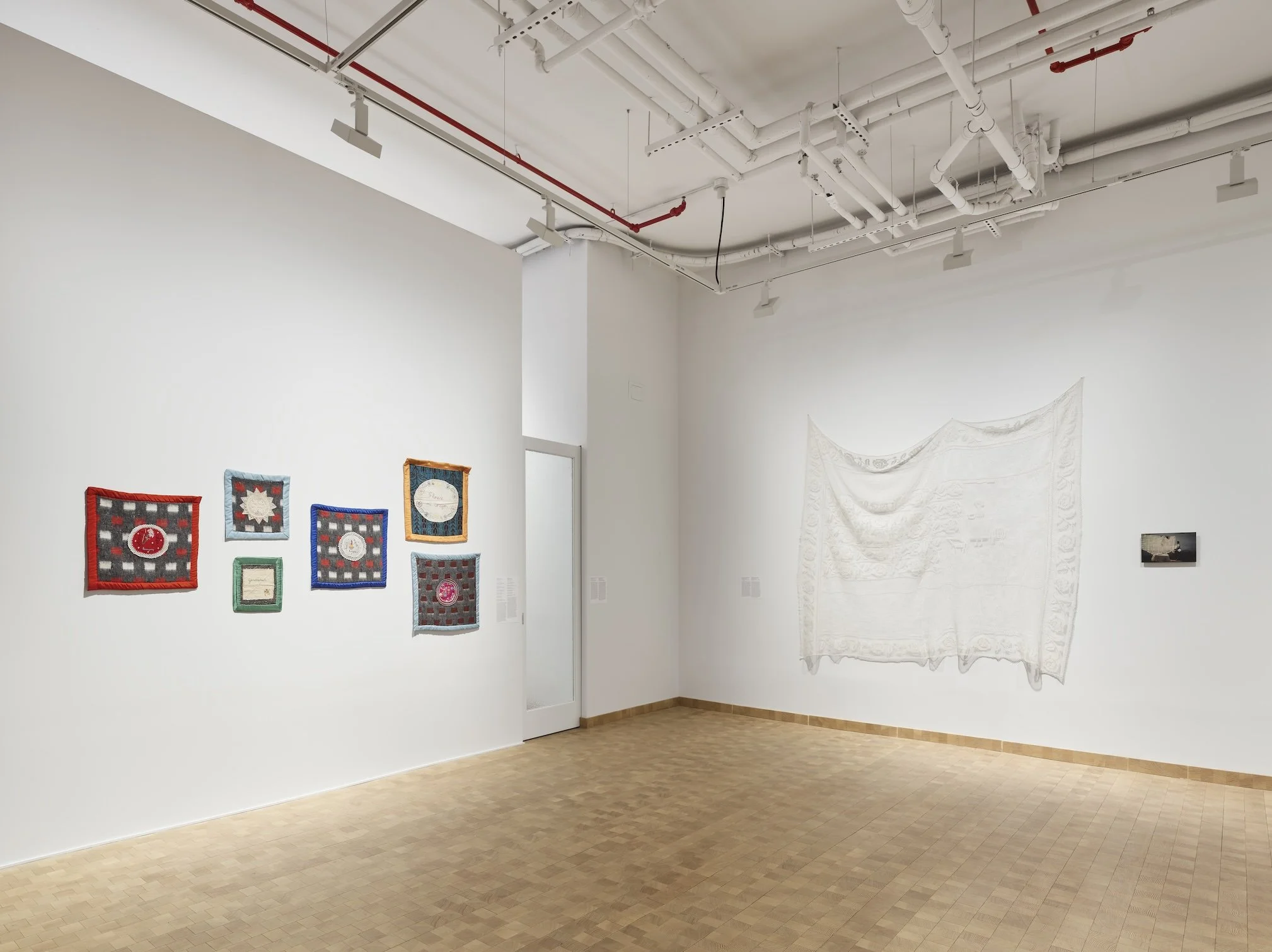Hot Coffee with curator Anna Burckhardt Pérez,The Neville Bryan Assistant Curator at the Art Institute of Chicago
Anna Burckhardt Pérez curated Threads to the South, an exhibition currently on view through July 27 at the Institute of Studies of Latin American Art located at 142 Franklin Street,New York. This thoughtful exhibition is fully aligned with the mission of the Institute to facilitate a deeper engagement with the Latin American visual and intellectual traditions by bringing us multi-generational and interdisciplinary dialogues of contemporary artists.Threads to the South features works by over twenty artists from ten countries, including videos, photographs, paintings, works on paper, and textiles developed between 1967 and 2023. After visiting this stimulating show I was compelled to ask its curator some questions.
Nina: Imagine you are in your favorite coffee or tea spot. Where is it? What are you drinking? What are the three things you see right now?
Anna: I try to avoid caffeine and don’t frequent coffee or tea shops very much. These days, I’m happiest in Bogotá, my hometown, anywhere that might have lulo juice, a reggaetón playlist, or a view of the Andes mountains.
Installation view of Threads to the South, Institute for Studies on Latin American Art (ISLAA), New York, 2024. Photo: Olympia Shannon.
Nina: Please tell me more about the exhibition "Threads to the South" you have curated at the ISLAA. What prompted this exhibition? Why now?
Anna:When the ISLAA team invited me to curate a show that would highlight their great holdings of art made with fiber, I was excited to have an opportunity to localize the thinking around textiles within Latin America. There have been several wonderful exhibitions in the last couple of years that have sought to bring textiles and fiber art to the center of the Western art historical canon, which is a very important work that is also long overdue. For Threads to the South, however, I was interested in exploring the importance of locality and marginality when it comes to the use of textile and fiber practices in a region like Latin America. A lot of artists who work with the medium are engaging with lineages of making that have been passed down through generations. These practices have often been labeled as ‘craft’ and, therefore, historically ignored by institutionalized art spaces, both in the United States and Europe as well as in Latin America.
As I began to study ISLAA’s collection more closely, I noticed that several artists were looking at these histories of textile practices in the region—whether it be pre-Columbian weaving traditions or embroidery techniques that they learned from their mothers—as a way to connect to a root that they perceived to have been lost due to the histories of colonization with which the region has grappled, or to personal experiences of violence, displacement and migration. Fiber is of course a very personal medium, it mediates a lot of our interactions with the world. In this sense, it became a very apt tool to explore the ways in which artists craft, question, or reconstruct an identity—personal or collective—and a sense of belonging in a region that lives with the realities of colonialism and imperialism, which are systems that to this day force us to look outside, towards the North.
Installation view of Threads to the South, showing works by Cecilia Vicuña and Marta Palau, Institute for Studies on Latin American Art (ISLAA), New York, 2024. Photo: Olympia Shannon.
Nina: Could you pick one work or thread of works currently on view and zero in on it (them)? Why are they presented?
Anna:The exhibition begins with Vaso de leche, Bogota (1979), a work by Cecilia Vicuña which documents a performance that she organized while living in Colombia, during the early years of Augusto Pinochet’s US-backed dictatorship in Chile. In it, the artist spilled a glass of milk on the street by tugging at a red yarn made of vicuña wool. The work was created after the Chilean group Colectivo Acciones de Arte (CADA) issued a call to action—in their work Para no morir de hambre en el arte (So as Not to Die of Hunger in Art)—to distribute packets of powdered milk in an impoverished area of Santiago. Vicuña wanted to respond to her local context as well and chose to draw attention to a recent scandal, in which almost two thousand children had died in Colombia after drinking contaminated milk that had been distributed by a private company. In addition to pulling the thread, Vicuña wrote a poem in white chalk on the pavement, equating milk with blood. The act of tugging the red thread, therefore, evokes blood that is being violently spilled, from both human and territorial bodies.
Vaso de leche, Bogota is a key piece in Threads to the South not only because it establishes a political connection between fiber and the territory, but also because it can be clearly read as a conceptual work of art. Exhibitions that deal with textile and fiber art often focus on technique, highlighting the skilled ways in which material is manipulated. I was interested in exploring thread not just as a material but also as a conceptual tool that allows artists to create connections with histories of making and resistance in Latin America. The exhibition, therefore, showcases a wide range of fiber-based practices—from works that feature a single yarn, like Vicuna’s, to pieces made with synthetic blankets, to very sophisticated weavings. In doing so, the show attempts to push past the hierarchical, and very Western, distinction between art and craft that so often plagues discussions around fiber.
Another example of this approach is Elvira Espejo Ayca’s Jiwasan amayusa / El pensar de nuestras filosofías (The Thinking of Our Philosophies, 2019), a three-part video work that honors the education that is passed down through generations of Bolivian weavers. In the video, the artist, who is a weaver herself, appears spinning cotton using her hands and a rueca, highlighting an embodied knowledge that establishes a direct connection between the weaver, the materials that she uses, and the territory from which they are harvested. This is known by many Indigenous and campesino communities in Latin America as sentipensar: a composite of the verbs “feel” (sentir) and “think” (pensar). An important concept for Threads to the South, it speaks to how practices of making, particularly around fiber, can subvert colonial ways of thinking and, therefore, create alternative histories that don’t rely on references to the Western canon.
Installation view of Threads to the South, showing works by Antonio Dias and Anna Bella Geiger, Institute for Studies on Latin American Art (ISLAA), New York, 2024. Photo: Olympia Shannon.
Nina: As a curator who works with legacies of colonialism and hence intergenerational trauma do you think that the artists you brought together for this show can bring some sort of reckoning with the past that goes beyond symbols and metaphors? In other words, could artists be facilitators of a dialogue between power structure and societal forces that addresses difficult, sometimes violent pasts?
Anna: Most of the works in Threads to the South attempt to question and push against certain established systems of power, whether directly or indirectly. There is, for example, an entire section that looks at the use of flags as both powerful tools for protest as well as dangerous symbols of a constructed national identity that enables oppressive regimes. These works are the most overtly political in the exhibition. The artists who made them chose fiber as their medium, a material that can be transported very easily, because it allows the works to live outside of traditional art spaces and therefore engage directly with the world. Hélio Oiticica’s Seja marginal, seja herói (Be an Outlaw, Be a Hero, 1969), for example, was often displayed at concerts and other events where members of the counterculture would gather. The work was created as a symbol of the possibilities of marginality but, as it was embraced and appropriated by everyday people, it also acquired the capacity for concrete societal change in a country that had lived through years of a violent dictatorship.
At the same time, the exhibition showcases work that, while not explicitly political, argues for alternative ways of thinking that are not rooted in Western mentalities. My interest as a curator in the ‘craft’ practices of the so-called Global South stems from the fact that they are inherently community-based and community-building; they create connections between the members of a particular society and between humans and the rest of the territory. In this sense, they become a very powerful decolonial tool with which to question systems of power that are rooted in individualism and extractivism, and which have been imposed upon territories like Latin America by the Global North. One example of this, which is a key theme in Threads to the South, is the idea of a circular notion of time. A lot of the works in the show look at textiles and fiber as inherited practices that connect the artists to their ancestors. Rather than provoking a reckoning with the past—which implies that we must get over some of the things that have happened to us to move forward—these artists are arguing for an alternative conception of time, in which the past, the present and the future are constantly meeting each other.
Sandra Monterroso’s videos Colorando las hebras (Coloring the Strands, 2011) and Decolorando las hebras (Bleaching the Strands, 2011) are lovely examples of this. In the first work, the artist is seen learning the Mayan technique of dying fiber as a way to embody the knowledge of her ancestors, which she feels she had lost after the passing of her grandmother. In the second video, she is seen furiously scrubbing those same threads in the flowing waters of the river. In doing so, she is also pushing against colonial ideas of Indigenous people as relics of a by-gone past. By questioning some of the very foundations of colony and empire—-the notion of forward motion and progress—these artists are encouraging us to change our own mentalities and connect with the past in order to build alternative futures.
Installation view of Threads to the South, showing works by Feliciano Centurión and Mónica Millán, Institute for Studies on Latin American Art (ISLAA), New York, 2024. Photo: Olympia Shannon.
Nina: Traditionally women have been associated with the mastery of yearn, of weaving, and embroidery. How does this show address this association as women here are often acting as agents of change, but also as agents of memory?
Anna: The show tries to address this in two ways that might seem contradictory at first glance, but that I hope will make sense for people. On one hand, it recognizes that in the Western art historical tradition, fiber-based work has often been relegated to the margins precisely because of its association with women and the domestic space. On the other hand, it argues that, in Latin America, there are powerful reasons for which women are so closely linked to thread and fiber.
Through weaving, women have historically narrated the history of communities and entire civilizations. Because they are the holders of this key embodied knowledge they also act, as you say, as agents of memory, tasked with passing down key information to future generations. A lot of this important community-sustaining work takes place in the domestic space, which is referenced in several of the works in the show—-most explicitly in Feliciano Centurión’s embroidered blankets, which honor the craft practices that the artist learned from his mother and grandmother in Paraguay when he was a child. In this sense, Threads to the South attempts to question those Western systems that view the practices that belong in the domestic space as something that has been imposed on women, and instead exalts them as sources of power and even transgression.
Installation view of Threads to the South, Institute for Studies on Latin American Art (ISLAA), New York, 2024. Photo: Olympia Shannon.





